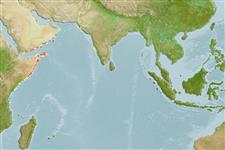Classification / Names
Nombres comunes | Sinónimos | Catalog of Fishes(Género, Especie) | ITIS | CoL | WoRMS | Cloffa
Environment: milieu / climate zone / depth range / distribution range
Ecología
marino asociado a arrecife; rango de profundidad 27 - 39 m (Ref. 93119). Tropical
Western Indian Ocean: Somalia.
Tamaño / Peso / Age
Maturity: Lm ? range ? - ? cm
Max length : 11.2 cm SL macho / no sexado; (Ref. 93119)
Short description
Morfología | Morfometría
Espinas dorsales (total): 9; Radios blandos dorsales (total): 11; Radios blandos anales: 11. This species is distinguished by the following characters: lower edge of preopercle as a stout antrorse spine; 2-4 preocular spines, usually with accessory spines on anterior base of largest; 5-6 count of diagonal scales; pelvic fin is blackish and lacks pattern of individual spots (Ref. 93119).
Life cycle and mating behavior
Madurez | Reproducción | Puesta | Huevos | Fecundidad | Larva
Knapp, L.W., 2012. Rogadius fehlmanni, a new flathead fish (Scorpaeniformes: Platycephalidae) from Somaliano access. Proc. Biol. Soc. Wash. 125(1):61-65. (Ref. 93119)
IUCN Red List Status (Ref. 130435)
Threat to humans
Harmless
Human uses
Más información
Nombres comunesSinónimosMetabolismoDespredadoresEcotoxicologíaReproducciónMadurezPuestaAgregación para la puestaFecundidadHuevosEgg development
Age/SizeCrecimientoLength-weightLength-lengthLength-frequenciesMorfometríaMorfologíaLarvaDinámica larvariaReclutamientoAbundanciaBRUVS
ReferenciasAcuiculturaPerfil de acuiculturaRazasGenéticaElectrophoresesheritabilidadEnfermedadesProcesamientoNutrientsMass conversion
ColaboradoresImágenesStamps, Coins Misc.SonidosCiguateraVelocidadTipo de nataciónSuperficie branquialOtolitosCerebrosVisión
Herramientas
Special reports
Download XML
Fuentes de Internet
Estimates based on models
Preferred temperature (Ref.
123201): 25.8 - 27.8, mean 26.1 °C (based on 5 cells).
Phylogenetic diversity index (Ref.
82804): PD
50 = 0.5078 [Uniqueness, from 0.5 = low to 2.0 = high].
Bayesian length-weight: a=0.00794 (0.00400 - 0.01577), b=3.08 (2.90 - 3.26), in cm total length, based on LWR estimates for this (Sub)family-body shape (Ref.
93245).
Nivel trófico (Ref.
69278): 3.6 ±0.6 se; based on size and trophs of closest relatives
Resiliencia (Ref.
120179): Alto, población duplicada en un tiempo mínimo inferior a 15 meses (Preliminary K or Fecundity.).
Fishing Vulnerability (Ref.
59153): Low vulnerability (10 of 100).
